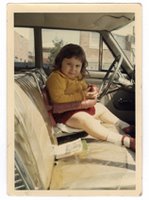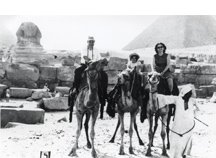

I love that quote, though I have to admit I know nothing about its author, L P Hartley. My past is a foreign country and in this particular image from my past, above, I’m in a foreign country (I’m in the middle, a rotund little American on the scrawny little camel). But it is less foreign to me than the image of the disgruntled car seat passenger in Flushing, Queens. I have no specific recollection of either moment (though I do remember quite a lot from the Egypt trip) but it is the Queens image that seems like an artifact to me. You’d think that the trip photo, being in black and white, would feel all the more distant-- in time, place, and representation. Instead its the foreignness of the car-- the full width seat, the plastic, the triangular vent window, the crudeness of the car seat, and quaintness of my outfit that strike me. Its the really forgettable, everyday details that change imperceptibly that somehow become so...memorable.
From the bits and pieces I've read (I know a little about a lot of things, which is not only dangerous, it makes for confusing blog entries) about Viktor Shlovsky’s concept of defamiliarization, i think it's very much related:
The technique of art is to make objects ‘unfamiliar’, to make forms difficult, to increase the difficulty and length of perception because the process of perception is an aesthetic end in itself and must be prolonged. Art is a way of experiencing the artfulness of an object; the object is not important." (Shklovsky, “Art as Technique”)The active intent present in "Art" -making is not there, but the effect is similar. In this case its the distance of time that increases the “length of perception.” Simply looking at an image of “the past” --random family snapshot or historical view-- allows one to “experience the artfulness of an object” if you're open to seeing it.
No comments:
Post a Comment